Ad
MongoDB Evenings DC: MongoDB - The New Default Database for Giant Ideas
- 1. Tweet tonight using #MongoDB to be entered to win a t-shirt!
- 2. Welcome to MongoDB Evenings DC! Agenda 6:00pm: Pizza, Beer & Soft Drinks 6:30pm: Welcome Andrew Lockman, Enterprise Account Executive, MongoDB 6:40pm: MongoDB: The New Default Database for Giant Ideas Gary Taylor, Senior Solutions Architect, MongoDB 7:30pm: Get MEAN and Lean with Docker and Kubernetes Vadim Polyakov, Director of Enterprise Architecture, Inovalon 8:15pm: Announcements Q&A #MongoDB @1776
- 3. MongoDB World Pre-conference training: June 27th Conference: June 28th-29th Hilton Midtown 1335 6th Avenue New York, NY 10019
- 4. Who’s Speaking (partial list)
- 6. Code “AndrewLockman” gets 25% off Early Bird Registration Ends May 13, 2016 June 29 - 29, 2016 New York, NY www.mongodbworld.com
- 7. MongoDB The New Default Database for GIANT Ideas Gary W.Taylor Senior SolutionsArchitect [email protected]
- 8. Agenda • The Changing World • The Relational Approach • Challenging the Relational Model • The MongoDB Way • When to use MongoDB • Enterprise Advanced Features • Use Cases Demo (time permitting)
- 10. Remember these?
- 11. Or these?
- 13. Internet Today
- 14. Software Has Changed •Higher up-front costs •Higher TCO • Lower up-front costs • Lower TCO
- 15. Data Has Changed • 90% of the world’s data was created in the last two years • 80% of enterprise data is unstructured • Unstructured data growing 2x faster than structured
- 16. What These Changes Mean YEARS ITERATIVE
- 17. Database Popularity in Today’s World http://db-engines.com/en/ranking
- 18. 2015 Gartner Magic Quadrant for Operational Database Management Systems
- 21. Modern Relational Underpinnings Expressive Query Language & Secondary Indexes Strong Consistency Enterprise Management & Integrations
- 22. Relational In Today’s World
- 23. Relational Data Model This is hard… Long time to develop Queries are complex Difficult to change
- 25. Car – A Relational View
- 26. How we really want to view the car
- 29. Database Timeline Magnetic tape “flat” (sequential) files Pre-computer technologies: Printing press Dewey decimal system Punched cards Magnetic Disk IMS Relational Model defined Indexed-Sequential Access Mechanism (ISAM) Network Model IDMS ADABAS System R Oracle V2 Ingres dBase DB2 Informix Sybase SQL Server Access Postgres MySQL Cassandra Hadoop Vertica Riak HBase Dynamo MongoDB Redis VoltDB Hana Neo4J Aerospike Hierarchical model 1960-701940-50 1950-60 1970-80 1980-90 1990-2000 2000-2010 Dell Software Group 40 Years Ago Today Relational (SQL) Non-Relational (NoSQL)
- 31. NoSQL Challenger’s Underpinnings Scalability & Performance Always On, Global Deployments FlexibilityExpressive Query Language & Secondary Indexes Strong Consistency Enterprise Management & Integrations
- 32. The MongoDB Way
- 33. What’s MongoDB? (short version) • MongoDB (from “humongous”) is a full-featured scalable, high-performance and developer friendly open source document-oriented database. • Instead of storing your data in tables and rows as you would with a relational database, in MongoDB you store JSON-like documents with dynamic schemas. • MongoDB bridges the gap between key-value stores (which are fast and scalable) and relational databases (which have rich functionality). • Using BSON (binary JSON), developers can easily map to modern object-oriented languages without a complicated ORM layer. • This new data model simplifies coding significantly, and also improves performance by grouping relevant data together internally.
- 34. What’s MongoDB for •We’re for modern, mission-critical and the previously impossible •We’re for #GIANTideas
- 35. MongoDB’s Nexus Architecture Scalability & Performance Always On, Global Deployments FlexibilityExpressive Query Language & Secondary Indexes Strong Consistency Enterprise Management & Integrations
- 36. { first_name: "Paul", surname: "Miller", cell: 447557505611, city: "London", { "type": "Point”, "location”: [- 0.145280,51.510907] }, Profession: ["banking", "finance", "trader"], cars: [ { model: "Bentley", year: 1973, value: 100000, … }, { model: "Rolls Royce", year: 1965, value: 330000, … } ] } MongoDB Document Model RDBMS
- 37. MongoDB vs. SQL terminology MongoDB SQL Database Database Collection Table/View Document Record/Tuple PK: _id Field PK: Any Attribute(s) Dynamic Schema Fixed Schema Index Index Embedded Document Joins Shard Partition
- 38. Documents are Rich Data Structures{ first_name: "Paul", surname: "Miller", cell: 447557505611, city: "London", loc: { "type": "Point”, ”coordinates”: [-0.145280,51.510907] }, Profession: ["banking", "finance", "trader"], cars: [ { model: "Bentley", year: 1973, value: 100000, … }, { model: "Rolls Royce", year: 1965, value: 330000, … } ] } Fields can contain an array of sub- documents Fields Typed field values Fields can contain arrays
- 39. Document Model Benefits { first_name: "Paul", surname: "Miller", cell: 447557505611, city: "London", loc: { "type": "Point”, ”coordinates”: [- 0.145280,51.510907] }, Profession: ["banking", "finance", "trader"], cars: [ { model: "Bentley", year: 1973, value: 100000, … }, { model: "Rolls Royce", year: 1965, value: 330000, … } ] } Agility and flexibility Data model supports business change Rapidly iterate to meet new requirements Intuitive, natural data representation Eliminates ORM layer Developers are more productive Reduces the need for joins, disk seeks Programming is simpler Performance delivered at scale
- 40. Dynamic Schema (polymorphic) { policyNum: 123, type: “auto”, customerId: “abc”, payment: 1200, deductible: 500, make: “Taurus”, model: “Ford”, VIN: “123ABC456”, miles_driven_yr: 15000, start: “jan, 2016”, end: “jul, 2016” } Insurance Policy Collection { policyNum: 456, type: “life”, customerId: “efg”, payment: 240, policyValue: 125000, smoker: “no”, beneficiaries: [ {spouse: “jane”, percent: 80}, {child: “jack”, percent: 20} ], start: “jan, 2016”, end: “jul, 2016” } { policyNum: 789, type: “home”, customerId: “hij”, payment: 2300, deductible: 1000, square_footage: 3000, floodCoverage: “no”, street: “10 Maple Lane”, city: “Springfield”, state: “Maryland”, start: “jan, 2016”, end: “jul, 2016” }
- 41. Rich Queries • Find Paul’s cars • Find everybody in London with a car built between 1970 and 1980 db.vehicles.find({ first_name: “Paul” }) db.vehicles.find({ city: “London”, “cars.year” : { $gte : 1970, $lte : 1980 } }) { first_name: "Paul", surname: "Miller", cell: 447557505611, city: "London", loc: { "type": "Point”, ”coordinates”: [- 0.145280,51.510907] }, Profession: ["banking", "finance", "trader"], cars: [ { model: "Bentley", year: 1973, value: 100000, … }, { model: "Rolls Royce", year: 1965, value: 330000, … } ] } Fully Featured .
- 42. Geospatial • Find all of the car owners within 5 miles of Trafalgar Square { first_name: "Paul", surname: "Miller", cell: 447557505611, city: "London", loc: { "type": "Point”, ”coordinates”: [-0.145280,51.510907] }, Profession: ["banking", "finance", "trader"], cars: [ { model: "Bentley", year: 1973, value: 100000, … }, { model: "Rolls Royce", year: 1965, value: 330000, … } ] } var milesToRadian = function(miles) { var earthRadiusInMiles = 3963.2; return miles / earthRadiusInMiles; }; var landmark = db.landmarks.findOne({name: ”Trafalgar Square"}); var query = { "loc" : { $geoWithin : { $centerSphere : [landmark.loc.coordinates, milesToRadian(5) ] } } }; // Query points. db.vehicles.find(query).pretty(); Fully Featured ..
- 43. Fully Featured ... Text Search • Find all the cars with ‘leather seats’ in their description Aggregation • Calculate average value of every owner’s car collection & show the top 10 sorted descending by average value { first_name: "Paul", surname: "Miller", cell: 447557505611, city: "London", loc: { "type": "Point”, ”coordinates”: [-0.145280,51.510907] }, Profession: ["banking", "finance", "trader"], cars: [ { model: "Bentley", year: 1973, value: 100000, … }, { model: "Rolls Royce", year: 1965, value: 330000, … } ] } Native Binary JSON Support • Add other vehicle classes (boats, motorcycles) to Paul’s vehicle collection. Left Outer Join ($lookup) • Query for Paul’s cell # and lookup all calls made in the last 30 days.
- 44. Morphia MEAN Stack Java Python PerlRuby Support for the most popular languages and frameworks Drivers & Ecosystem
- 45. When To Use MongoDB
- 46. The important aspect of MongoDB • MongoDB was not designed for niche use cases • MongoDB strives to have excellent characteristics applicable to a very broad range of use cases MongoDB: the most balanced general purpose database for Enterprise applications and performance
- 47. MongoDB is good for • Single View • Internet of Things – sensor data • Mobile apps – geospatial • Real-time analytics • Catalog • Personalization • Content management • Inventory management • Personalization engines • Shopping cart • Dependent datamarts • Archiving for fast lookup • Collaboration tools • Messaging applications • Log file aggregation • Caching • Adserving • … Use Cases where MongoDB shines Mixture of analytics and archiving Build information from data as it comes in Extract from DW for analysis Large volume, targeted queries Sharing in near real time Twitter-like apps e.g., SPLUNK Enable massive reads on consolidated data
- 48. MongoDB Use Cases Single View Internet of Things Mobile Real-Time Analytics Catalog Personalization Content Management
- 49. Single View Internet of Things / Sensor Data Mobile Engagement Real-Time Analytics Open Data Personalization Content Management Department of Energy Customs and Immigration Service Veterans Affairs Intelligence Community Immigration and Customs Enforcement Federal Communications Commission Intelligence Community US Geological Survey Department of Homeland Security Defense Information Systems Agency Federal Aviation Administration Intelligence Community National Institutes of HealthConsumer Financial Protection Bureau Federal Law Enforcement Veterans Affairs US ArmyOffice of the Secretary of Defense MongoDB US Federal Use Cases
- 50. Best Fit for MongoDB over RDBMSs Data Variably or unstructured Hierarchical objects Geo-coordinates Disparate sources Schema changes often Querying Real-time analytics & aggregations Location-based Lowest latency Performance affects user experience Known relationships between entities Local reading/writing globally Other requirements Agile development Fastest time-to-market Cloud infrastructure Data will grow quickly Highest throughput Always on (~99.999%) availability Lowest TCO Challenges today with RDBMS
- 51. Best Fit for MongoDB over NoSQL Data Hierarchical objects Geo-coordinates Disparate sources Schema changes often Querying Secondary indexes useful Strong consistency desired In-DB analytics & aggregations Geospatial (location-based) SQL-based access & BI Other requirements Robust management tools Highest read/write concurrency Lowest TCO Full application DB Largest ecosystem Future proofing & recruiting Want to influence roadmap Commercial license desired
- 52. MongoDB does well • Straightforward replication • High performance on mixed workloads of reads, inserts, and updates • Scaling on demand • Location based deployment • Geospatial queries • High Availability and auto failover • Flexible schema & secondary indexing • Agile development in most programming languages • Commodity infrastructure • Real time analytics • Text indexing • Data consistency • Compression • … As a database, where does MongoDB shine? Easy to initiate All reads, mixed, and mostly writes No expensive overprovisioning One cluster can span the globe Easy to build relevant mobile apps Low stress operations No need for complex data modeling No need to give up your favorite development language No vendor lock-in through hardware Get value from data right away ! Basic search feature Simpler app design With new version 3.X
- 54. Only With Enterprise Advanced Storage Engines Encrypted Storage Engine In-Memory Storage Engine Tools MongoDB Compass MongoDB Connector for BI Ops Manager or Cloud Manager Premium Integrations Kerberos & LDAP Authentication Auditing SNMP Support Red Hat Identity Management Certification Platform Certification Windows, RedHat/CentOS, Ubuntu, Amazon Linux And … Private, On-Demand Training Support SLA 1 hour Support Availability 24 x 365 Emergency Patches Commercial License, Warranty, and Indemnification
- 55. Encrypted & In-memory Storage Engines In-memory storage engine offers the benefits of in-memory computing without sacrificing functionality or durability Encrypted storage engine natively encrypts database files on disk – for sensitive data, i.e., in regulated industries
- 56. MongoDB Compass For fast schema discovery and visual construction of ad-hoc queries • Visualize schema – Frequency of fields – Frequency of types – Determine validator rules • View Documents • Graphically build queries • Authenticated access
- 57. MongoDB Connector for BI Visualize and explore multi- dimensional documents using SQL- based BI tools. The connector does the following: • Provides the BI tool with the schema of the MongoDB collection to be visualized • Translates SQL statements issued by the BI tool into equivalent MongoDB queries that are sent to MongoDB for processing • Converts the results into the tabular format expected by the BI tool, which can then visualize the data based on user requirements
- 58. Monitoring & Alerting - Charts, dashboards & alerts on 100+ metrics Backup - Backup and restore, with point-in- time recovery Automation - Single-click provisioning, scaling out/back & rolling upgrades without downtime MongoDB Ops Manager The Best Way to Manage MongoDB In Your Data Center Typically around 95% Reduction in Operational Overhead
- 59. Integrates with Existing Infrastructure
- 60. MongoDB Enterprise Server MongoDB Enterprise Advanced24x7Support CommercialLicense Platform Certifications Emergency Patches On-Demand Online Training Customer Success Program MongoDB CompassMongoDB Ops Manager Monitoring & Alerting Query Optimization Backup & Recovery Automation & Configuration Schema Visualization Data Exploration Ad-Hoc Queries MongoDB Connector for BI Visualization Analysis Reporting LDAP & Kerberos Auditing FIPS 140-2Encryption at Rest REST API
- 61. Technical: Why MongoDB High performance (1000’s – millions queries / sec) - reads & writes Need flexible schema, rich querying with any number of secondary indexes Need for replication across multiple data centers, even globally Need to deploy rapidly and scale on demand (start small and fast, grow easily) 99.999% availability Real time analysis in the database, under load Geospatial querying Processing in real time, not in batch Need to promote agile coding methodologies Deploy over commodity computing and storage architectures Point in Time recovery Need strong data consistency Advanced security
- 62. Business: Why MongoDB Management tooling and services Ease of hiring Commercial license Ease of developer adoption Global Support Global Professional Services IT ecosystem integration Company stability De facto standard for next generation database
- 63. Summary • Wide range of use cases – and that’s the core point ! • Excellent across many possible use cases, not just a few • Recognized by Gartner and Forrester • De facto standard for next generation database • Enterprise maturity and integration • Built for GIANT Ideas!
- 65. Government DBaaS Government agency provides a centralized data store to manage veterans’ electronic records (VLER DAS) Problem Why MongoDB ResultsProblem Solution Results Internal and external systems need to exchange and store data through trusted connections to provide a full range of services to the veteran Clinicians needs accurate information to ensure quality patient treatment Benefits users needs accurate information for benefits adjudication Leverage flexible data model to save all types of electronic records via one centralized data service Scales easily using sharding to manage electronic records for the lifetime (and beyond) of all veterans Provides expressive query capabilities to meet the needs of each line of business Succeeded in rolling out system in 9 months, meeting Congressionally mandated deadline Common access mechanism to exchange and store veteran electronic records One place to store and manage veteran electronic records for the lifetime of the agency
- 66. Real-Time Geospatial Platform for Innovation Using MongoDB to create a smarter and safer city Problem Why MongoDB ResultsProblem Solution Results Siloed data across city departments made it difficult for the City of Chicago to intelligently analyze situations deliver services to its citizens City needed a system that could not only handle 7 million pieces of data / day from 30+ departments, but also run analytics across it to deliver insight Used MongoDB’s flexible data model to build the WindyGrid, a unified view of the city’s operations that brings together disparate datasets from 30 departments Leveraged MongoDB’s rich analytics features (aggregation framework, geospatial indexes, etc.) to create maps that deliver real-time insight Horizonal scalability with automatic sharding across commodity servers ensures the city can continue to cost effectively deliver real-time results A single view of the city’s operations on a map of Chicago is now available to all managers to help them better analyze and respond to incidents in real-time New predictive analytics system is planned that will help prevent crimes before they happen 450 data sets have been published to the public, sparking even further innovation, e.g., an app that alerts citizens when street sweepers are coming
- 67. What is Chicago’s WindyGrid? • A real-time situational awareness system that brings over a dozen data sources together into a single application. • Is built using open source software including MongoDB
- 68. What is Chicago’s OpenGrid? • A new project by the City of Chicago • An open-source, next generation version of WindyGrid • That will allow the public to navigate Chicago’s open data • Has a more intuitive interface.

























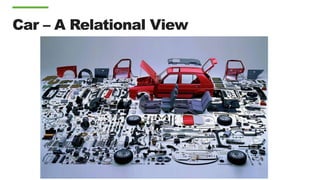










![{
first_name: "Paul",
surname: "Miller",
cell: 447557505611,
city: "London",
{
"type": "Point”, "location”: [-
0.145280,51.510907]
},
Profession: ["banking", "finance",
"trader"],
cars: [
{ model: "Bentley",
year: 1973,
value: 100000, … },
{ model: "Rolls Royce",
year: 1965,
value: 330000, … }
]
}
MongoDB
Document Model
RDBMS](https://image.slidesharecdn.com/washdcmongodbeveningsthenewdefaultdbforgiantideas20160412final2-160413040804/85/MongoDB-Evenings-DC-MongoDB-The-New-Default-Database-for-Giant-Ideas-36-320.jpg)

![Documents are Rich Data Structures{
first_name: "Paul",
surname: "Miller",
cell: 447557505611,
city: "London",
loc: {
"type": "Point”, ”coordinates”: [-0.145280,51.510907]
},
Profession: ["banking", "finance", "trader"],
cars: [
{ model: "Bentley",
year: 1973,
value: 100000, … },
{ model: "Rolls Royce",
year: 1965,
value: 330000, … }
]
}
Fields can contain an array of sub-
documents
Fields
Typed field values
Fields can contain
arrays](https://image.slidesharecdn.com/washdcmongodbeveningsthenewdefaultdbforgiantideas20160412final2-160413040804/85/MongoDB-Evenings-DC-MongoDB-The-New-Default-Database-for-Giant-Ideas-38-320.jpg)
![Document Model Benefits
{
first_name: "Paul",
surname: "Miller",
cell: 447557505611,
city: "London",
loc: {
"type": "Point”, ”coordinates”: [-
0.145280,51.510907]
},
Profession: ["banking", "finance", "trader"],
cars: [
{ model: "Bentley",
year: 1973,
value: 100000, … },
{ model: "Rolls Royce",
year: 1965,
value: 330000, … }
]
}
Agility and flexibility
Data model supports business change
Rapidly iterate to meet new requirements
Intuitive, natural data representation
Eliminates ORM layer
Developers are more productive
Reduces the need for joins, disk seeks
Programming is simpler
Performance delivered at scale](https://image.slidesharecdn.com/washdcmongodbeveningsthenewdefaultdbforgiantideas20160412final2-160413040804/85/MongoDB-Evenings-DC-MongoDB-The-New-Default-Database-for-Giant-Ideas-39-320.jpg)
![Dynamic Schema (polymorphic)
{
policyNum: 123,
type: “auto”,
customerId: “abc”,
payment: 1200,
deductible: 500,
make: “Taurus”,
model: “Ford”,
VIN: “123ABC456”,
miles_driven_yr: 15000,
start: “jan, 2016”,
end: “jul, 2016”
}
Insurance Policy Collection
{
policyNum: 456,
type: “life”,
customerId: “efg”,
payment: 240,
policyValue: 125000,
smoker: “no”,
beneficiaries: [
{spouse: “jane”, percent:
80},
{child: “jack”, percent: 20}
],
start: “jan, 2016”,
end: “jul, 2016”
}
{
policyNum: 789,
type: “home”,
customerId: “hij”,
payment: 2300,
deductible: 1000,
square_footage: 3000,
floodCoverage: “no”,
street: “10 Maple Lane”,
city: “Springfield”,
state: “Maryland”,
start: “jan, 2016”,
end: “jul, 2016”
}](https://image.slidesharecdn.com/washdcmongodbeveningsthenewdefaultdbforgiantideas20160412final2-160413040804/85/MongoDB-Evenings-DC-MongoDB-The-New-Default-Database-for-Giant-Ideas-40-320.jpg)
![Rich
Queries
• Find Paul’s cars
• Find everybody in London with a car built
between 1970 and 1980
db.vehicles.find({
first_name: “Paul”
})
db.vehicles.find({
city: “London”,
“cars.year” : {
$gte : 1970,
$lte : 1980
}
})
{
first_name: "Paul",
surname: "Miller",
cell: 447557505611,
city: "London",
loc: {
"type": "Point”, ”coordinates”: [-
0.145280,51.510907]
},
Profession: ["banking", "finance",
"trader"],
cars: [
{ model: "Bentley",
year: 1973,
value: 100000, … },
{ model: "Rolls Royce",
year: 1965,
value: 330000, … }
]
}
Fully Featured .](https://image.slidesharecdn.com/washdcmongodbeveningsthenewdefaultdbforgiantideas20160412final2-160413040804/85/MongoDB-Evenings-DC-MongoDB-The-New-Default-Database-for-Giant-Ideas-41-320.jpg)
![Geospatial
• Find all of the car owners within 5 miles of
Trafalgar Square
{
first_name: "Paul",
surname: "Miller",
cell: 447557505611,
city: "London",
loc: {
"type": "Point”, ”coordinates”:
[-0.145280,51.510907]
},
Profession: ["banking",
"finance", "trader"],
cars: [
{ model: "Bentley",
year: 1973,
value: 100000, … },
{ model: "Rolls Royce",
year: 1965,
value: 330000, … }
]
}
var milesToRadian = function(miles) {
var earthRadiusInMiles = 3963.2;
return miles / earthRadiusInMiles;
};
var landmark = db.landmarks.findOne({name: ”Trafalgar Square"});
var query = {
"loc" : {
$geoWithin : {
$centerSphere : [landmark.loc.coordinates, milesToRadian(5) ]
}
}
};
// Query points.
db.vehicles.find(query).pretty();
Fully Featured ..](https://image.slidesharecdn.com/washdcmongodbeveningsthenewdefaultdbforgiantideas20160412final2-160413040804/85/MongoDB-Evenings-DC-MongoDB-The-New-Default-Database-for-Giant-Ideas-42-320.jpg)
![Fully Featured ...
Text Search
• Find all the cars with ‘leather seats’ in their
description
Aggregation
• Calculate average value of every owner’s car
collection & show the top 10 sorted
descending by average value
{
first_name: "Paul",
surname: "Miller",
cell: 447557505611,
city: "London",
loc: {
"type": "Point”, ”coordinates”:
[-0.145280,51.510907]
},
Profession: ["banking",
"finance", "trader"],
cars: [
{ model: "Bentley",
year: 1973,
value: 100000, … },
{ model: "Rolls Royce",
year: 1965,
value: 330000, … }
]
}
Native Binary
JSON Support
• Add other vehicle classes (boats,
motorcycles) to Paul’s vehicle collection.
Left Outer Join
($lookup)
• Query for Paul’s cell # and lookup all calls
made in the last 30 days.](https://image.slidesharecdn.com/washdcmongodbeveningsthenewdefaultdbforgiantideas20160412final2-160413040804/85/MongoDB-Evenings-DC-MongoDB-The-New-Default-Database-for-Giant-Ideas-43-320.jpg)



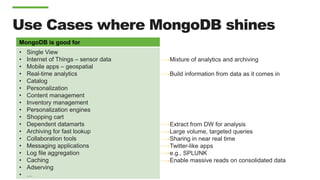

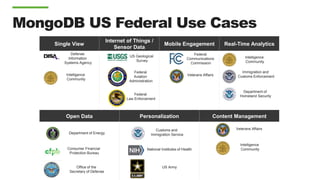
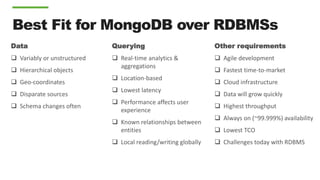



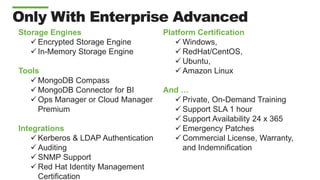



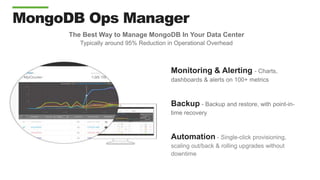






















































































![MongoDB .local San Francisco 2020: Powering the new age data demands [Infosys]](https://cdn.slidesharecdn.com/ss_thumbnails/315pminfosysfinalsfoversionvocalpart1-200120221508-thumbnail.jpg?width=560&fit=bounds)































